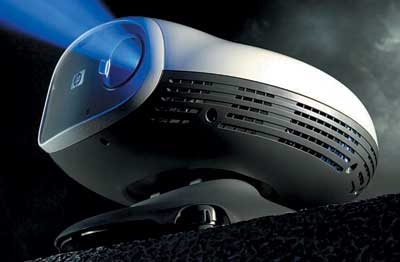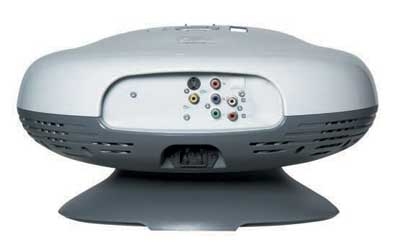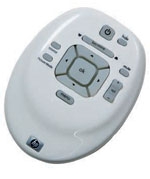Big-Screen Megabargains Page 4
HP Simple setup and smooth looks
HP (Hewlett-Packard) is traditionally linked with computers, PDAs, and printers, but these days computer makers have their hands in everything. So it came as no surprise when HP entered the home theater field last year with a line of DLP projectors. At $1,399, the ep7100 is the company's entry-level model. Its 4:3 aspect ratio, 800 x 600-resolution DLP chip doesn't provide the same level of flexibility as the InFocus and NEC projectors if you have a 16:9 screen (more on that later). But unlike many projectors, which have an industrial look and feel and a gazillion adjustments, the ep7100 is simple for a novice to set up and use. 
|
The HP's user-friendly nature is echoed in its design. The white and gray pod-like projector looks at home on a coffee table - like an affable robot that's been programmed to entertain. It's a little bulky, and its fan noise is a bit loud, but I usually recommend mounting these puppies on the ceiling out of the way.
The computer mouse-shaped remote itself is a study in simplicity, with buttons for menu navigation, power on/off, toggling video inputs, and switching picture modes - that's it. The sparse keypad is backlit, making it easy to use in dark rooms. One thing I didn't like was the remote's weak infrared output - unlike the other two projectors, which can be controlled by bouncing remote commands off the screen, the ep7100 needs a direct line of sight to the remote.
SETUP The ep7100 can be used for watching widescreen programs, but its 4:3 display chip suits it best for displaying standard-shaped sources like regular TV and videogames. If you plan to use it with a 16:9 screen (as I did, since I used the same screen with all three projectors), you'll have to select Widescreen Input from the picture menu during setup. The downside is that you'll be using just a 16:9 chunk of the 4:3 array of pixels to display images - it's the same as when you watch a letterboxed wide-screen program on a standard-shape rear-projection or direct-view TV. 
There's a bare minimum of other setup options: horizontal and vertical picture shift, White Intensity adjustment, and a Picture Enhancement slider (some sort of gamma adjustment). Unlike the other projectors, the ep7100 has no low-power mode to lengthen bulb life and reduce fan noise.
 PICTURE QUALITY It didn't take much work to get the HP to look good with DVDs. In a scene from Wild at Heart where Marietta intercepts a call to her daughter from Sailor, her skin had a slightly pinkish cast but appeared natural otherwise. And as the camera slowly zoomed in on her twisted, martini-slurping face, both a lemon wedge and her candy-red lips looked vibrant.
PICTURE QUALITY It didn't take much work to get the HP to look good with DVDs. In a scene from Wild at Heart where Marietta intercepts a call to her daughter from Sailor, her skin had a slightly pinkish cast but appeared natural otherwise. And as the camera slowly zoomed in on her twisted, martini-slurping face, both a lemon wedge and her candy-red lips looked vibrant.
Although the HP's picture looked the softest of the three projectors with DVDs, its contrast and shadow detail were impressive. For example, when Lula and Sailor encounter a car accident on an empty highway, the desert sky held its dark intensity even with headlight beams cutting across it.
Standard cable programs didn't fare as well as DVDs. I saw occasional stairstepped "jaggies" in scenes with fast motion, and the green backgrounds in my Golf Channel torture test looked so smoothed over as to be completely robbed of detail. To be fair, however, standard programs would have looked sharper if I'd watched them with the projector configured for a 4:3 screen.
If you find the idea of setting up a front projector kind of scary, HP's ep7100 is for you. It offers good overall video performance, an easy-to-use interface, and a stripped-down feature set designed to prevent confusion.
PDF: Features ChecklistPDF: In the Lab
The Bottom LineFront projectors used to be a luxury item that only the rich and famous could afford. But those days are long gone - solid-performing models for less than $1,500 make a true home theater experience available to a broader segment of the DVD-watching public. Given my choice of these three projectors, I'd be hanging the InFocus on my ceiling in a heartbeat. I found some shortcomings with the NEC's picture, but I also appreciated its extensive setup options and near-silent fan. And the HP strikes me as an impressive freshman effort. So with all these options, why settle for a big-screen TV when you can get really, really big-screen entertainment for the same amount of money?
- Log in or register to post comments










































